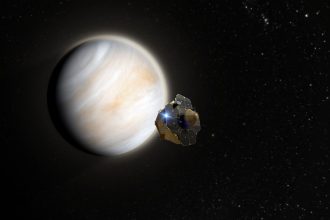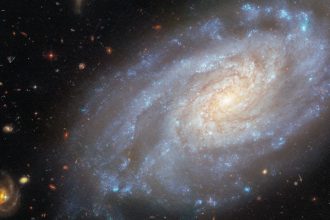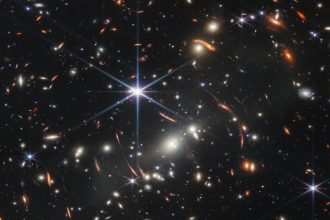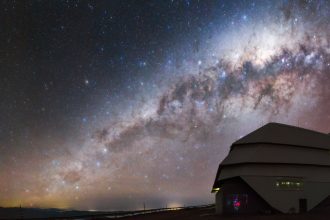
Astronomers have spotted the biggest flare ever seen erupting around a black hole, which also happens to be the most distant flare of this type ever detected.
Discovered using the Zwicky Transient Facility (ZTF), the flare erupted from the supermassive black hole at the heart of an Active Galactic Nucleus (AGN) designated J2245+3743 and located in the center of a galaxy 10 billion light-years away from Earth. AGNs are central regions of galaxies that are dominated by feeding, or “accreting,” supermassive black holes.
The supermassive black hole in J2245+3743 is feeding on surrounding gas and dust whirling around it in a flattened cloud shape called an accretion disk, but this flare is actually the result of something else: an unusually massive star venturing too close to the black hole which has a mass 500 million times greater than the sun). The tremendous gravitational influence of the black hole is ripping apart the star, and its stellar remains are being fed to this cosmic titan — an occurrence scientists call a tidal disruption event, or TDE.
You may like
“This is unlike any AGN we’ve ever seen,” Matthew Graham, team leader at theCalifornia Institute of Technology (Caltech) and a ZTF scientist, said in a statement. “The energetics show this object is very far away and very bright.”
The flare was first spotted in 2018 by the ZTF, with astronomers watching as it brightened by a factor of 40 over the course of a few months. At its peak, the flare was 30 times brighter than any prior black hole flare, emitting as much energy as 10 trillion suns. The previous most powerful TDE was the event nicknamed “Scary Barbie,” which comes from its official designation ZTF20abrbeie.
“If you convert our entire sun to energy, using Albert Einstein’s famous formula E = mc^2, that’s how much energy has been pouring out from this flare since we began observing it,” K. E. Saavik Ford, team member and City University of New York (CUNY) Graduate Center researcher, said in the statement.
This black hole flare is continuing to fade, and that indicates to the researchers that it is still swallowing the unfortunate star that ventured too close to it, which is estimated to have had an initial mass of 30 times that of the sun (for comparison, the star being devoured in the Scary Barbie event is thought to have just three to 10 times the mass of the sun).
As Graham colorfully puts it, the ongoing nature of the flare in J2245+3743 is akin to “a fish only halfway down the whale’s gullet.”
Helping the team continue to study this flare is the fact that the gravity surrounding supermassive black holes is so great that time itself runs slower as you get closer to the outer light-trapping boundary, or “event horizon.”
“It’s a phenomenon called cosmological time dilation due to the stretching of space and time. As the light travels across expanding space to reach us, its wavelength stretches as does time itself,” Graham said. “Seven years here is two years there. We are watching the event play back at quarter speed.”
You may like
This time dilation effect is exactly why long-term surveys like that conducted by the ZTF are so useful.
The J2245+3743 flare is of scientific interest for another reason. Astronomers have spotted around 100 TDEs thus far, and most haven’t occurred in an AGN. This could be because the natural activity of supermassive black holes and the emissions that come from the accretion disk around them can camouflage TDEs. That makes TDEs around already feeding black holes tougher to spot than those involving quiet non-feeding supermassive black holes. But the huge size of J2245+3743 made it more conspicuous than most AGN-based TDEs.
Even so, this black hole flare didn’t immediately present itself as something special to the team. It wasn’t until 2023, five years after it was initially sighted, that data from the W. M. Keck Observatory in Hawaii revealed the extremely energetic nature of this flare.
At first, it was also important to establish that this extreme object was truly this bright and with energy escaping in all directions, not just directed straight at Earth. The team ruled this possibility out using data from NASA’s retired Wide-field Infrared Survey Explorer (WISE).
The team also ruled out a massive supernova explosion as the cause of this flare, thus confirming this to be the brightest black hole flare ever detected and indicating it represents a TDE involving an exceptionally massive star.
“Supernovas are not bright enough to account for this. Stars this massive are rare, but we think stars within the disk of an AGN can grow larger,” Ford said. “The matter from the disk is dumped onto stars, causing them to grow in mass.”
The discovery of this powerful flare indicates that such events could be occurring across the cosmos, just waiting to be uncovered. The team will continue to go back through ZTF looking for similar events while awaiting data from the Vera C. Rubin Observatory, which could also find usually powerful TDEs.
“We never would have found this rare event in the first place if it weren’t for ZTF,” Graham concluded. “We’ve been observing the sky with ZTF for seven years now, so when we see anything flare or change, we can see what it has done in the past and how it will evolve.”
The team’s research was published on Tuesday (Nov.4) in the journal Nature Astronomy.


















